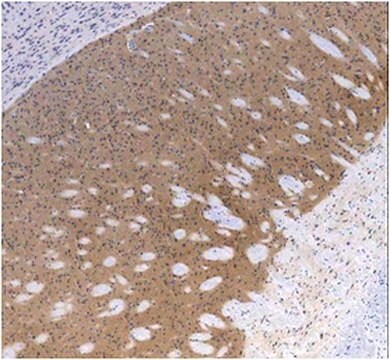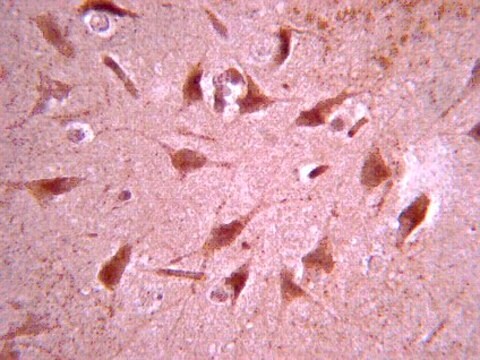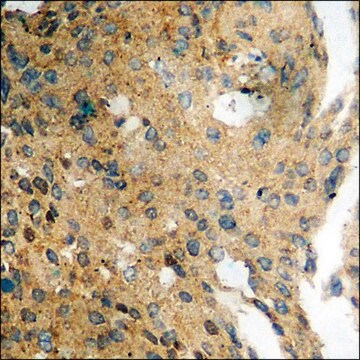324390
Anti-Dopamine D₁ Receptor Rabbit pAb
lyophilized, Calbiochem®
Sign Into View Organizational & Contract Pricing
All Photos(1)
About This Item
UNSPSC Code:
12352203
NACRES:
NA.41
Recommended Products
biological source
rabbit
Quality Level
antibody form
serum
antibody product type
primary antibodies
clone
polyclonal
form
lyophilized
does not contain
preservative
species reactivity
human, mouse, rat
manufacturer/tradename
Calbiochem®
storage condition
OK to freeze
isotype
IgG
shipped in
ambient
storage temp.
2-8°C
target post-translational modification
unmodified
Gene Information
human ... DRD1(1812)
rat ... Drd1(24316)
General description
Rabbit polyclonal antibody supplied as lyophilized, undiluted serum. Recognizes the ~50 kDa dopamine D1 receptor protein.
Recognizes the dopamine D1 receptor in rat brain. Does not cross-react with other dopamine receptors.
This Anti-Dopamine D₁ Receptor Antibody is validated for use in ELISA, WB, Frozen Sections, Free-Floating Sections, Paraffin Sections for the detection of Dopamine D₁ Receptor.
Immunogen
Human
a synthetic peptide (MDGTGLVVERDFSC) corresponding to amino acids 9-21 of human D₁dopamine receptor
Application
ELISA (see comments)
Immunoblotting (1:1000)
Frozen Sections (1:5000)
Free-Floating Sections (1:5000)
Paraffin Sections (not recommended)
Immunoblotting (1:1000)
Frozen Sections (1:5000)
Free-Floating Sections (1:5000)
Paraffin Sections (not recommended)
Warning
Toxicity: Standard Handling (A)
Physical form
Undiluted serum.
Reconstitution
Reconstitute the antibody with 100 µl PBS containing 1% BSA. For further dilution of the antibody use a similar buffer formulation. Following reconstitution, refrigerate (4°C).
Analysis Note
Positive Control
Rat brain
Rat brain
Other Notes
Mignini, F., et al. 2000. J. Autonom. Pharmacol.20, 325.
This antibody has also been reported to work in ELISA. For blocking immunoblot membranes, use ONLY 4% goat serum or evaporated goat′s milk. For frozen sections a 1:5000 dilution of the reconstituted serum demonstrates specific staining of rat brain sections including the medial septum, nucleus accumbens, dentate gyrus, globus pallidus, medial forebrain bundle, cortex regions 1-3, substantia nigra reticulata, and the ventral tegmental area. Strong nuclear staining of oligodendrocytes was also observed. Variables associated with assay conditions will dictate the proper working dilution.
Legal Information
CALBIOCHEM is a registered trademark of Merck KGaA, Darmstadt, Germany
Not finding the right product?
Try our Product Selector Tool.
Storage Class Code
11 - Combustible Solids
WGK
WGK 1
Flash Point(F)
Not applicable
Flash Point(C)
Not applicable
Certificates of Analysis (COA)
Search for Certificates of Analysis (COA) by entering the products Lot/Batch Number. Lot and Batch Numbers can be found on a product’s label following the words ‘Lot’ or ‘Batch’.
Already Own This Product?
Find documentation for the products that you have recently purchased in the Document Library.
Jacqueline S Coley et al.
PloS one, 10(2), e0117450-e0117450 (2015-02-04)
Drug abuse is a major comorbidity of HIV infection and cognitive disorders are often more severe in the drug abusing HIV infected population. CD14+CD16+ monocytes, a mature subpopulation of peripheral blood monocytes, are key mediators of HIV neuropathogenesis. Infected CD14+CD16+
Tina M Calderon et al.
Journal of neuroimmune pharmacology : the official journal of the Society on NeuroImmune Pharmacology, 12(2), 353-370 (2017-01-31)
In human immunodeficiency virus-1 (HIV) infected individuals, substance abuse may accelerate the development and/or increase the severity of HIV associated neurocognitive disorders (HAND). It is proposed that CD14+CD16+ monocytes mediate HIV entry into the central nervous system (CNS) and that
Florian Giesert et al.
PloS one, 8(5), e63778-e63778 (2013-05-16)
Missense mutations in the leucine-rich repeat kinase 2 gene (LRRK2) are linked to autosomal dominant forms of Parkinson's disease (PD). In order to get insights into the physiological role of Lrrk2, we examined the distribution of Lrrk2 mRNA and different
Our team of scientists has experience in all areas of research including Life Science, Material Science, Chemical Synthesis, Chromatography, Analytical and many others.
Contact Technical Service






